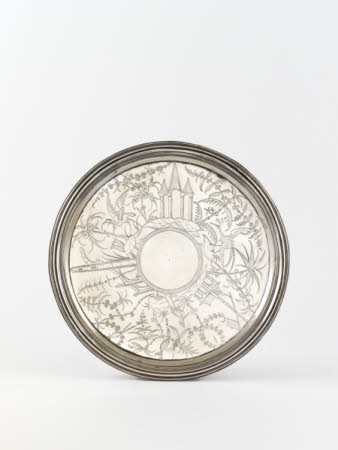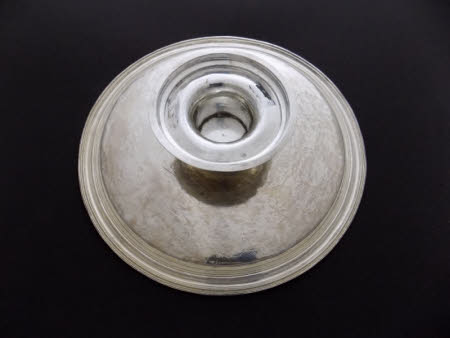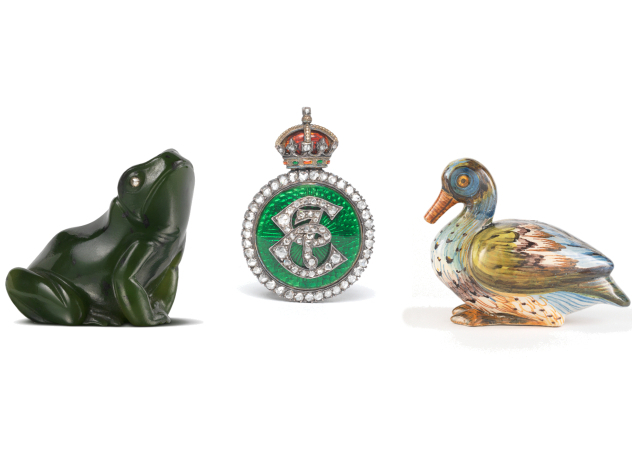Salver
possibly Thomas Smith (fl. 1679-1689)
Category
Silver
Date
1683 - 1684
Materials
silver
Measurements
38.5 cm (diam.)
Place of origin
London
Order this imageCollection
Polesden Lacey, Surrey
NT 1246855
Summary
Footed salver, sterling silver, possibly by Thomas Smith (free of the Goldsmiths’ Company 1680), London, 1683/4. The circular salver with moulded border is raised as is the applied trumpet foot. The flat, upper surface of the salver has contemporary chased Chinese and Japanese inspired decoration in the style now known as Chinoiserie. It is comprised of birds, trees and trailing plants around arcaded buildings, one with a tower and another with a flagpole. There is a central, undecorated reserve bounded by a band of matting, the outer chased line of which is drawn into a series of six points. Hallmarks: marked on the top with maker’s mark ‘TS’ in monogram crowned, possibly for Thomas Smith (fl. 1679-89) [David Mitchell, Silversmiths in Elizabethan and Stuart England, 2017, p. 556], leopard’s head crowned for London, lion passant for sterling and ‘f’ for 1683/4. The base of the foot is marked with the lion passant only.
Full description
Salvers emerged as a form in the early 17th century and were associated with the service of drink. Early on they were often supplied with a two-handled covered cup for use with formal toasting, and for display on the sideboard, and Samuel Pepys was probably referring to such a pairing when he recorded receiving a ‘Faire State-dish of silver and cup’ as a gift in 1663.[1] This tradition continued well into the 18th century for royal Christening gifts, the 1st Earl Brooke (subsequently also Earl of Warwick) as late as 1746 receiving on behalf of his child ‘One Large Gilt Cup Cover & Salver’ from George II.[2] The 1661 edition of Thomas Blount’s Glossographia (dictionary) defines ‘Salver (from salvo, to Save)’ as being ‘a new fashioned peece of wrought plate, broad and flat, with a foot underneath, and is used in giving Beer, or other liquid thing, to save or preserve the Carpit or Cloathes from drops.’[3] The rims of such salvers were generally broader initially but had been minimised by the late 1670s, as on this example. A single stem foot continued to be the norm during the first two decades of the 18th century but thereafter was rapidly supplanted by three or more low feet beneath the rim. There was also a proliferation in uses and sizes in the 18th century and the term ‘waiter’ was often favoured over ‘salver’.[4] The flat-chased decoration of the salver with Chinese and Japanese inspired buildings, plants and birds is contemporary and is one of the most lavish and high-quality surviving examples of the style then generally known as ‘Japan work’ but now referred to as chinoiserie. For a decade or so from around 1680 there was little short of a frenzy for chinoiserie on silver, undertaken predominantly by unidentified London-based specialist chasers, and this was part of a wider vogue for items from or inspired by east and south Asia. Chinese and Japanese porcelain and lacquer and Indian textiles were imported in great quantities, and they were available as inspiration for European designers alongside such illustrated books as Johan Nieuhof’s An Embassy ... to ... China of 1665 (translated into English 1669), Athanasius Kircher’s China Illustrata (1667) and Olfert Dapper’s Atlas Chinensis (1671). These sources would have been interpreted, merged and embellished by pattern drawers with the intention of satisfying the desire for something playful, exotic and highly fashionable.[5] It is rare consequently for details to be able to be matched to an exact source but the pinnacle-like tower at the end of the arched viaduct on the Polesden salver is probably an interpretation of the pagodas illustrated, notably that in the Fujian province in Kircher’s China Illustrata, and the angled flagpole on the arcaded building opposite very likely derives from those in a number of the engravings in Nieuhof. There is also a striking similarity between the arched viaduct and tower on the Polesden salver and that on a contemporary salver in the collection at Birmingham Museum and Art Gallery (ref. 1968M3). Both may have drawn on the same pattern-maker’s design, and perhaps even have been executed in the same workshop.[6] The decline of the fashion for chinoiserie decoration on silver coincided with the rise of Huguenot silversmiths in Britain and Ireland and it is noteworthy that, without exception, they did not embrace the style, instead achieving a clean sweep with their sophisticated and up-to-the-minute French baroque designs. The maker’s mark on the Polesden salver - ‘TS’ interjoined under a crown - has been suggested by David Mitchell to be possibly that of Thomas Smith, who became free of the Goldsmiths’ Company in 1680.[7] The mark is found on at least four other pieces with chinoiserie decoration[8], one of them another salver with complementary decoration and marked for the same year which is very probably the pair to Polesden’s[9]. This supports the authenticity of the Polesden piece and further corroboration was provided in 2020 by a group of experts who visited Polesden Lacey under the aegis of the Silver Society. A second flurry of enthusiasm for silver with chinoiserie decoration occurred in the early decades of the 20th century when collectors paid enormous sums for late Stuart silver in general and chinoiserie pieces in particular. Mrs Greville was keen to follow the trend and had the wherewithal to pay whatever was required. No details survive of how she acquired the salver or when exactly but it is likely that she did so, as with her pictures, through a dealer who perhaps sourced all her other chinoiserie pieces. She assembled what may in her lifetime have been the largest individual collection in the country and it probably remains so today, albeit that many of the pieces other than the salver are now thought to be fakes - at least as far as their decoration goes. The salver, along with much of the rest of Mrs Greville’s Stuart silver, was recorded following her death as having been in her London house, 16 Charles Street, Berkeley Square. The house had an enormous dining room and it would have been on the table there, along with other pieces, that the salver would have been displayed at the glittering assemblies of political and society figures gathered for lunches and dinners. In 1930 the Daily Telegraph recorded that ‘Mrs. Greville is very proud of her rare silver’. James Rothwell, National Curator, Decorative Arts, with assistance from Emile de Bruijn, Assistant National Curator, Decorative Arts. April 2022 NOTES: [1] Beth Carver Wees, English Irish and Scottish Silver at the Sterling and Francine Clark Art Institute, 1997, p. 90. [2] The National Archives, LC 9/45, Jewel Office Delivery Book 1732-93, f. 95. Subsequently a basin or a dish replaced the salver. Pairings of ewers and basins were the other favoured form for royal Christening gifts, two 19th century examples of which given by Queen Adelaide are preserved at Belton - NT 436588. [3] Thomas Blount, Glossographia, or, A dictionary interpreting all such hard words of whatsoever language now used in our refined English tongue ..., London, 1661; Early English Books Online Text Creation Partnership, http://name.umdl.umich.edu/A28464.0001.001, accessed 6 April 2022. See also Timothy Schroder, British and Continental Gold and Silver in the Ashmolean Museum, 2009, vol. 1, p. 211. [4] One of the best examples of this proliferation is at Dunham Massey (NT). See James Lomax and James Rothwell, Country House Silver from Dunham Massey, 2006, pp. 64-8, 87-93, 130-33, 145 & Appendix 2, pp. 167-83. [5] The most comprehensive assessments of sources for Chinoiserie decoration on silver can be found in James Lomax, ‘Chinoiserie Silver in Britain’ in David Beevers (ed.), Chinese Whispers: Chinoiserie in Britain 1650-1930, Brighton 2008, pp. 38-51, and in Philippa Glanville’s essay, ‘English 17th Century Chinoiserie Silver’ in the Sotheby’s New York sale catalogue, 21 May 1992, ‘The Jaime Ortiz-Patino Collection: 17th Century English Chinoiserie Silver’. [6] The Birmingham salver, which is one of a pair, is illustrated in ibid, fig. 3.3, p. 40. It bears the unidentified maker’s mark ‘D’ and does not have a date letter but is circa 1682. There is a truncated version of the viaduct and a similar tower on the Brownlow tankards of 1686/7 by John Duck, Smith’s former master: sold Christie’s, 13 June 2000, lot 19. The ruined arch next to the tower on the Polesden salver is also comparable to that on a tankard of 1689/90, maker’s mark YT, sold by Freeman’s, Philadelphia, 15 December 2015, lot 15. [7] David Mitchell, Silversmiths in Elizabethan and Stuart England, London 2017, p. 556. [8] For two see ibid. The third, a two handled cup of 1685/6 associated with the coronation of James II, is in the Royal Collection(RCIN 46299) and the fourth, a two handled cup of 1684/5, was sold by Smith & Singer, Australia, 25 October 2010, lot 350. [9] Sotheby’s, New York, 21 May 1992, ‘The Jaime Ortiz-Patino Collection: 17th Century English Chinoiserie Silver’, lot 141. This piece, like the Polesden salver, exhibits three structures amidst birds, trees and trailing plants around a central, undecorated reserve. If they were a pair, as seems likely, they might well have been supplied with associated cups and covers.
Provenance
Acquired by Margaret McEwan, The Hon. Mrs Ronald Greville (1863-1942), probably in the early 20th century; recorded as having been at 16 Charles Street, Berkeley Square in the valuation for probate drawn up after her death; bequeathed with Polesden Lacey to the National Trust in memory of Mrs Greville’s father, William McEwan (1827-1913).
Credit line
Polesden Lacey, the Greville Collection (National Trust)
Marks and inscriptions
On the upper surface: Maker’s mark ‘TS’ in monogram crowned, possibly for Thomas Smith (fl. 1679-89) [David Mitchell, Silversmiths in Elizabethan and Stuart England, 2017, p. 556], leopard’s head crowned for London, lion passant for sterling and ‘f’ for 1683/4. Base of foot: Lion passant for sterling.
Makers and roles
possibly Thomas Smith (fl. 1679-1689), goldsmith




